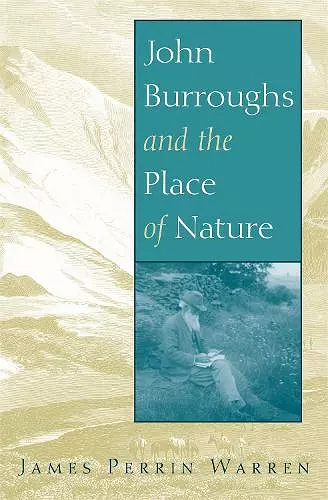John Burroughs and the Place of Nature
Format:Hardback
Publisher:University of Georgia Press
Published:13th Feb '06
Currently unavailable, and unfortunately no date known when it will be back

This study situates John Burroughs, together with John Muir and Theodore Roosevelt, as one of a trinity of thinkers who, between the Civil War and World War I, defined and secured a place for nature in mainstream American culture. Though not as well known today, Burroughs was the most popular American nature writer of his time. Prolific and consistent, he published scores of essays in influential large-circulation magazines and was often compared to Thoreau. Unlike Thoreau, however, whose reputation grew posthumously, Burroughs wasa celebrity during his lifetime: he wrote more than thirty books, enjoyed a continual high level of visibility, and saw his work taught widely in public schools.
James Perrin Warren shows how Burroughs helped guide urban and suburban middle-class readers “back to nature” during a time of intense industrialization and urbanization. Warren discusses Burroughs’s connections not only to Muir and Roosevelt but also to his forebears Emerson, Thoreau, and Whitman. By tracing the complex philosophical, creative, and temperamental lineage of these six giants, Warren shows how, in their friendships and rivalries, Burroughs, Muir, and Roosevelt made the high literary romanticism of Emerson, Thoreau, and Whitman relevant to late-nineteenth- and early-twentieth-century Americans. At the same time, Warren offers insights into the rise of the nature essay as a genre, the role of popular magazines as shapers and conveyors of public values, and the dynamism of place in terms of such opposed concepts as retreat and engagement, nature and culture, and wilderness and civilization.
Because Warren draws on Burroughs’s personal, critical, and philosophical writings as well as his better-known narrative essays, readers will come away with a more informed sense of Burroughs as a literary naturalist and a major early practitioner of ecocriticism. John Burroughs and the Place of Nature helps extend the map of America’s cultural landscape during the period 1870-1920 by recovering an unfairly neglected practitioner of one of his era’s most effective forces for change: nature writing.
Despite the rise of contemporary ecocriticism, until now John Burroughs has remained the most neglected and least understood major figure in the history of U.S. nature writing. Warren handsomely redresses this imbalance in his wise and deeply informed unpacking of the complexities of Burroughs's relations with Ralph Waldo Emerson, Henry David Thoreau, and especially John Muir and Theodore Roosevelt. Warren thereby also provides the best account to date of the importance of nature writing itself at a pivotal moment in U.S. cultural history.
* author of The Environmental Imagination: Thoreau, Nature Writing, and the Formation of American Culture *A comprehensive, insightful reading of one of America's greatest nature writers. Warren covers Burroughs' entire career, carefully calibrating his character and achievements against those of his influential companions Thoreau, Whitman, Roosevelt, and Muir while, at the same time, evoking their distinctive literary styles and environmental values. It is easy to see how Burroughs' original combination of lyric natural history, agrarian pastoral, cultural criticism, and biophilia could inspire millions of readers from school children to presidents. Beautifully written and deeply informed, this book will speak not only to ecocritics and environmental historians, but to anyone who cherishes the green and living earth.
* author of The Cincinnati Arch: Learning from Nature in the City *For readers interested in nature writing, ecocriticism, and/or environmental history, Warren's book will prove indispensable. John Burroughs and the Place of Nature is scholarship in the richest, broadest sense: it uses solid research and direct, accessible prose to tell a compelling story about Burroughs and his place within various larger contexts of environmental representation.
* editor of Reading the Roots: American Nature Writing before WaldenISBN: 9780820327884
Dimensions: 235mm x 156mm x 24mm
Weight: 553g
280 pages